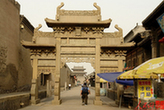a. Brief Introduction
This 800-year-old habitation of the Naxi people is noteworthy for its harmony with nature, ingenious architecture and urban facilities.
Lying in a broad, fertile valley in the northwest of Yunnan Province, the old town of Lijiang has been a commercial, political and cultural center of the Naxi people and other ethnic minorities for over eight centuries.
It was designated as a town around the beginning the Yuan Dynasty (1271-1368). From 1253 on, the Naxi people of Lijiang developed a unique social system, customs and culture of their own under the rule of a hereditary succession of chieftains of the Mu clan. In the 18th century, the Qing Dynasty rulers implemented a policy of cultural interaction, and the Naxi people adopted the customs of the Tibetan and Han peoples. Despite several earthquakes that afflicted Lijiang, and because of renovation, most of the old town retains its original structure.
Lijiang is surrounded by the snow-covered Yulong Mountains. "There are four seasons on one mountain," says a folk song about Yulong, "and the scenery changes every ten li (five km)." The Lijiang area is known as a treasure house of animals and plants, and a huge natural reservoir. Water flowing down from melting glaciers and snow high in the mountains irrigates the fields and provides water for the residents.
Water, in fact, flows everywhere in Lijiang. Crystal-clear streams wind around all the houses and flows through the courtyards. Stone bridges span the streams. Streets paved with colored stones, including Sifang (Square) Street, are thus kept free from dust and mud in all seasons. The source of these streams is the Yuquan (Jade Spring) River, which meanders past the foot of Xiangshan (Elephant) Hill, north of Lijiang. In addition, there is the Baimalong (White-Horse Dragon) Pool and wells sunk around the numerous springs. The local people have made ponds along the courses of the springs. The upper ponds supply drinking water, the middle ponds are for washing vegetables, and the lower ponds are for washing clothes. The spring water that overflows the banks is used for washing the streets.





Why not rent a boyfriend, or girlfriend to please parents during the Spring Festival?